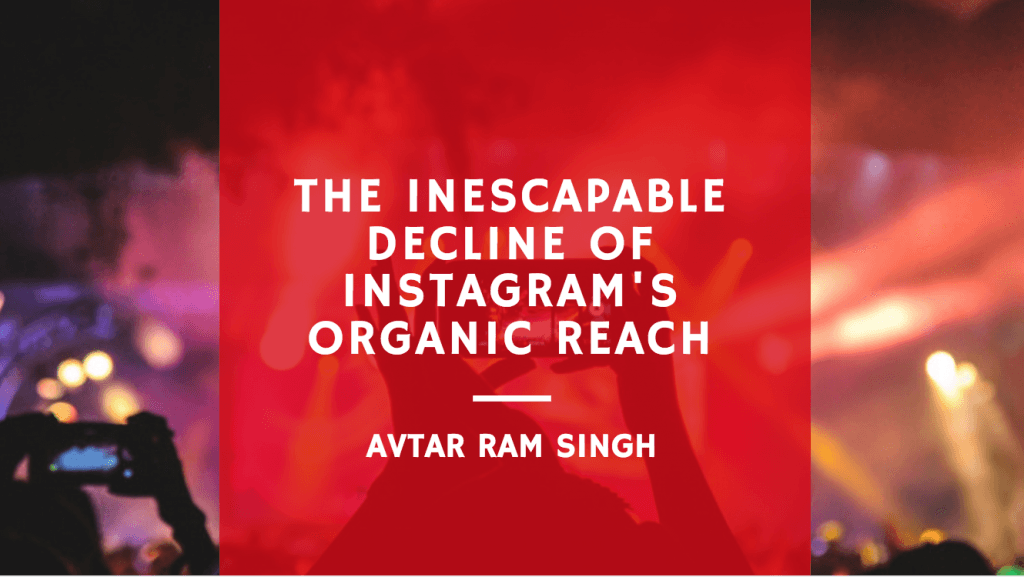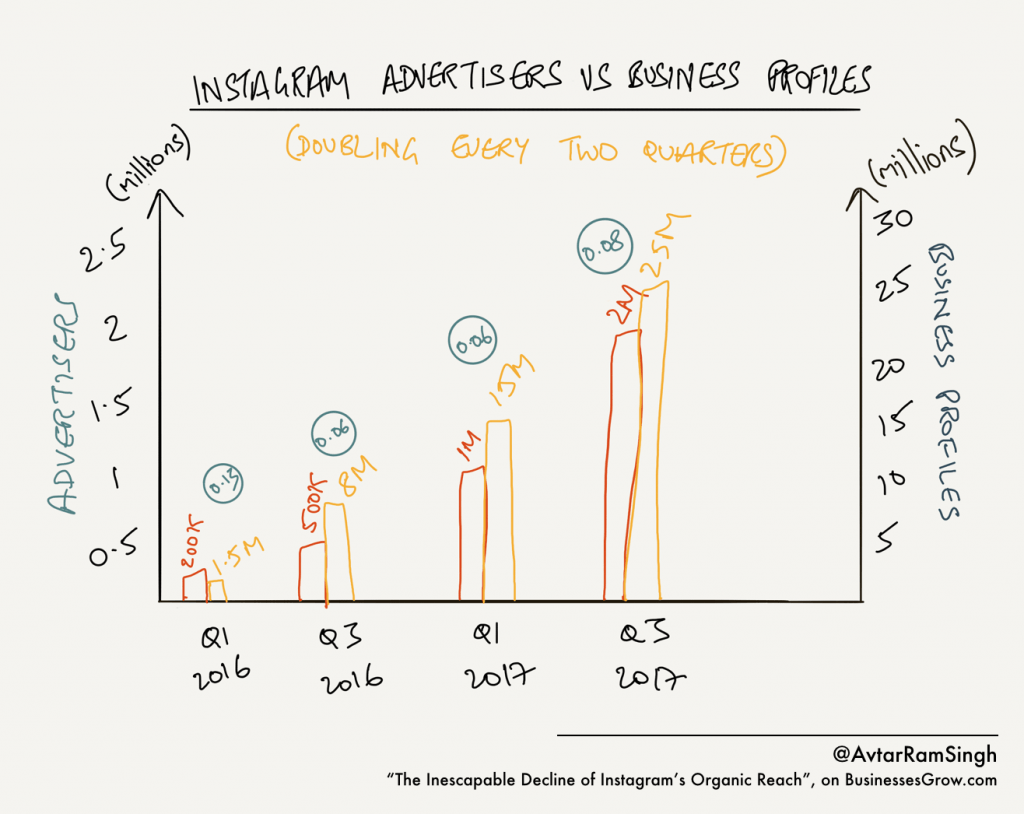By Avtar Ram Singh, {grow} Contributing Columnist
At the end of the first quarter of 2014, advertising powerhouse Ogilvy reported what many digital marketing professionals had been saying for more than a year. The organic reach of Facebook pages was in steep decline. That report, Facebook Zero, was widely circulated by marketing folk around the world and caused a certain level of marketing chaos.
Two years before that, Facebook had hit the 1 billion users mark, and had reported that 42 million Facebook pages existed on the platform.
But this was a fact that most marketers had known for a while. Many had begun building their audiences outside of Facebook’s rented land, and had started using the already robust Facebook advertising tool to reach their audience, at prices that were peanuts compared to the Facebook advertising costs of today. This is the famous chart that first created Facebook anxiety in 2014:

The widely circulated data. Courtesty: Statista & Social@Ogilvy
It was a time of turmoil, and denial. Many small businesses blamed Facebook for “baiting” them, for building a community on the platform and then taking away their ability to reach them without paying for it. Many boycotted the platform, others tried their best to create “content” that was geared to be shared but not to help grow sales or build a brand, many lost patience with the platform and decided to pivot to Twitter, Google+ and other platforms that promised free and high organic reach.
In my mind, this is where a lot of social media marketers went astray. They began creating content for the sake of content, using engagement-bait and click-bait to scrape whatever interactions and clicks they could, and gave the industry a terrible name.
I took you down memory lane because I believe we’re going to see another such period in social media marketing, and this time with Instagram, which is also owned by Facebook.
A Billion Users, the Battle with Snapchat
A few months ago, Instagram hit a momentous milestone. A billion users. They joined the “three comma club” and became Facebook’s fourth property – after Instagram, Messenger and Facebook itself, to hit a billion users. The battle between Instagram and Snapchat is over. Instagram has won, hands down. I saw a damning statistic the other day illustrating that Instagram has added more new users in the last year, than Snapchat has in total.
The most important factors in Instagram defeating Snapchat in my mind, were:
- A bigger network-effects play: They utilised the pre-existing Instagram platform to build Stories on, and took away the “ephemeral content” crowd from Snapchat.
- Feature Packed Stories: By introducing polls, quizzes, GIFs, locations and so much more in IG Stories, IG became far more interesting and “sticky” for users.
- Easy Advertising Transition: By providing advertisers with the ability to run Instagram ads via Facebook’s ads manager, they made it incredibly easy (a click of a mouse button, I kid you not) to get advertisers to spend a little bit of money on Instagram.
- Low Advertising Costs: This varies greatly by industry and region, but on the whole, it’s been far cheaper to advertise on Instagram (CPM-wise). This however, is slowly changing.
The Startling Growth in Advertiser Figures
As of September 2017, Instagram had 2 million advertisers using the platform – they haven’t updated this figure since. Facebook crossed that milestone in February 2015, and since then has tripled the number of advertisers on it.
In Instagram’s case, it’s 2 million advertisers trying to reach 1 billion Instagram users, and for Facebook, it’s 6 million advertisers trying to reach 2.2 billion Facebook users. It’s crazy when you think about it, there’s an advertiser for every 500 Instagram users, and and an advertiser for every ~350 Facebook users.
Facebook grew this advertiser figures for Instagram by making it incredibly easy to transition to running Instagram ads, by keeping advertising costs fairly low on the platform to start with and continuing to offer content formats that can be used on the platform only via the Ads Manager.
How then, will they continue to scale the number of advertisers on the platform, as they try to generate more revenue from the platform? In my mind, they’ll resort to what caused the biggest increase in Facebook’s advertiser count.
Facebook hit a million advertisers in June 2013. The decline in organic reach began a few months later. Six months after that, Facebook Zero and the widespread paranoia of the drop in organic reach was a key discussion point, with marketers resigning to their fate of needing to spend money on Facebook to continue to reach their audience.
A year later, Facebook doubled their advertiser count.
The Potential, and the Need to Reach that Potential
As of April 2018, Facebook has 80 million business pages on it. Compare that to 6 million advertisers, and one in every 13 business pages is an advertiser. For Instagram, that number is a little different. There are 25 million Instagram business profiles on the platform, and a total of 2 million advertisers. That too, is around 1 in every 13 business profiles. An interesting parity in percentage penetration of advertisers.
I’d argue that for Instagram, the number of businesses on the platform are definitely a lot more. After the ability to convert an Instagram profile into a business profile were announced, there was widespread speculation that converting to a business profile lowered your reach. A number of marketers chose not to convert their page into a business profile – so I’d suspect that there are tons of businesses on Instagram not registered as a business profile.
From a pure business perspective, Facebook would like nothing more than to have each and every one of those 80 million pages using the advertising function. And by extension, nothing more than to have each of the 25 million (and more) Instagram business profiles advertising on Instagram.
The percentage of potential advertisers to active advertisers on the Facebook and Instagram platforms are going to become increasingly important for Instagram to monitor. If the number of advertisers doesn’t grow, the growth can only come from an increase in ad-spending from existing advertisers. Making Facebook ads more expensive to run has some effect, but the majority of large budget advertisers have strict advertising figures to stick to.
The numbers I’ve sketched out in the little blue circles on the graph, show that percentage. And for Instagram, that number can’t be growing fast enough.
Today’s Reality, and Tomorrow’s Requirements
In reality, here’s where Facebook and Instagram stand today:
- Facebook has reached a point where they cannot continue to rely on the Facebook platform for all of its advertising revenue, the biggest piece of their business revenue pie.
- Instagram has shown incredible growth, both in users and in advertisers, and is a cash cow waiting to be properly milked, but with a smart and sensible approach.
- Facebook has steadily grown the advertiser and business profile count on the platform, with the business profile growth shooting past that of the number of advertisers.
- Instead of increasing the cost of advertising on Instagram and risking Instagram being dubbed “too expensive” to advertise on, the smarter play is to do exactly what they did with Facebook – decrease the organic reach of pages.
- Most Instagram business profiles have reached a “sizeable” following figure, where abandoning the platform because of low reach becomes impossible. After investing the time and effort to build these communities, marketers will continue to strive to reach their audience.
Some of us have known this for a while, some of us have always thought this day would come.
It’s inevitable … only a matter of time.






